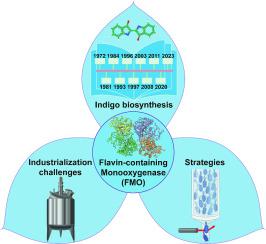当前位置:
X-MOL 学术
›
Biotechnol. Adv.
›
论文详情
Our official English website, www.x-mol.net, welcomes your
feedback! (Note: you will need to create a separate account there.)
Overview of indigo biosynthesis by Flavin-containing Monooxygenases: History, industrialization challenges, and strategies
Biotechnology Advances ( IF 12.1 ) Pub Date : 2024-05-08 , DOI: 10.1016/j.biotechadv.2024.108374 Changxin Fan 1 , Ziqi Xie 1 , Da Zheng 1 , Ruihan Zhang 1 , Yijin Li 2 , Jiacheng Shi 1 , Mingyuan Cheng 1 , Yifei Wang 2 , Yu Zhou 3 , Yi Zhan 3 , Yunjun Yan 3
Biotechnology Advances ( IF 12.1 ) Pub Date : 2024-05-08 , DOI: 10.1016/j.biotechadv.2024.108374 Changxin Fan 1 , Ziqi Xie 1 , Da Zheng 1 , Ruihan Zhang 1 , Yijin Li 2 , Jiacheng Shi 1 , Mingyuan Cheng 1 , Yifei Wang 2 , Yu Zhou 3 , Yi Zhan 3 , Yunjun Yan 3
Affiliation

|
Indigo is a natural dye extensively used in the global textile industry. However, the conventional synthesis of indigo using toxic compounds like aniline, formaldehyde, and hydrogen cyanide has led to environmental pollution and health risks for workers. This method also faces growing economic, sustainability, and environmental challenges. To address these issues, the concept of bio-indigo or indigo biosynthesis has been proposed as an alternative to aniline-based indigo synthesis. Among various enzymes, Flavin-containing Monooxygenases (FMOs) have shown promise in achieving a high yield of bio-indigo. However, the industrialization of indigo biosynthesis still encounters several challenges. This review focuses on the historical development of indigo biosynthesis mediated by FMOs. It highlights several factors that have hindered industrialization, including the use of unsuitable chassis (), the toxicity of indole, the high cost of the substrate L-tryptophan, the water-insolubility of the product indigo, the requirement of reducing reagents such as sodium dithionite, and the relatively low yield and high cost compared to chemical synthesis. Additionally, this paper summarizes various strategies to enhance the yield of indigo synthesized by FMOs, including redundant sequence deletion, semi-rational design, cheap precursor research, NADPH regeneration, large-scale fermentation, and enhancement of water solubility of indigo.
中文翻译:

含黄素单加氧酶生物合成靛蓝的概述:历史、工业化挑战和策略
靛蓝是一种在全球纺织工业中广泛使用的天然染料。然而,传统的靛蓝合成方法使用苯胺、甲醛、氰化氢等有毒化合物,导致环境污染和工人健康风险。这种方法还面临着日益增长的经济、可持续性和环境挑战。为了解决这些问题,已经提出了生物靛蓝或靛蓝生物合成的概念作为基于苯胺的靛蓝合成的替代方案。在各种酶中,含黄素单加氧酶 (FMO) 在实现生物靛蓝的高产率方面表现出了良好的前景。然而,靛蓝生物合成的工业化仍面临一些挑战。本综述重点介绍 FMO 介导的靛蓝生物合成的历史发展。它强调了阻碍工业化的几个因素,包括使用不合适的底盘()、吲哚的毒性、底物L-色氨酸的高成本、产品靛蓝的水不溶性、需要钠等还原剂与化学合成相比,连二亚硫酸盐收率相对较低,成本较高。此外,本文还总结了提高 FMO 合成靛蓝产量的各种策略,包括冗余序列删除、半理性设计、廉价前体研究、NADPH 再生、大规模发酵和增强靛蓝水溶性。
更新日期:2024-05-08
中文翻译:

含黄素单加氧酶生物合成靛蓝的概述:历史、工业化挑战和策略
靛蓝是一种在全球纺织工业中广泛使用的天然染料。然而,传统的靛蓝合成方法使用苯胺、甲醛、氰化氢等有毒化合物,导致环境污染和工人健康风险。这种方法还面临着日益增长的经济、可持续性和环境挑战。为了解决这些问题,已经提出了生物靛蓝或靛蓝生物合成的概念作为基于苯胺的靛蓝合成的替代方案。在各种酶中,含黄素单加氧酶 (FMO) 在实现生物靛蓝的高产率方面表现出了良好的前景。然而,靛蓝生物合成的工业化仍面临一些挑战。本综述重点介绍 FMO 介导的靛蓝生物合成的历史发展。它强调了阻碍工业化的几个因素,包括使用不合适的底盘()、吲哚的毒性、底物L-色氨酸的高成本、产品靛蓝的水不溶性、需要钠等还原剂与化学合成相比,连二亚硫酸盐收率相对较低,成本较高。此外,本文还总结了提高 FMO 合成靛蓝产量的各种策略,包括冗余序列删除、半理性设计、廉价前体研究、NADPH 再生、大规模发酵和增强靛蓝水溶性。































 京公网安备 11010802027423号
京公网安备 11010802027423号